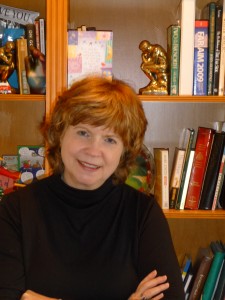 Kerrie Logan Hollihan’s sixth book with CRP is her second for YA readers. In the Fields and the Trenches traces the true experiences of 18 young adults who came of age during World War I—the Great War. The century-old tales convey surprisingly modern, universal themes of love, death, power, courage, fear, family, friendship, and sacrifice. Here, Kerrie shares how she went about researching and capturing these important pieces of history and why they matter for teen readers.
Kerrie Logan Hollihan’s sixth book with CRP is her second for YA readers. In the Fields and the Trenches traces the true experiences of 18 young adults who came of age during World War I—the Great War. The century-old tales convey surprisingly modern, universal themes of love, death, power, courage, fear, family, friendship, and sacrifice. Here, Kerrie shares how she went about researching and capturing these important pieces of history and why they matter for teen readers.
This is a really unique collection of stories in that many of your subjects are names we still know today (though not necessarily in association with World War I), and others we don’t know at all. Yet, the stories all come together very naturally as a whole. How did the idea for the book come about?
I wanted to write this book for a while. When I wrote Theodore Roosevelt for Kids, I read about the Roosevelts and World War I. All of the Roosevelt sons, one daughter, and two spouses took part, and one died. Their war stories—a father, a mother, and their grown children—captured both Victorian views and the new reality of mechanized warfare. Flying machines and poison gas were hardly in TR’s thinking when he led a charge on horseback during the Spanish American War.
How did you go about choosing which historic figures would be part of the book? Were there any big names that were left on the cutting-room floor?
In part I chose historic figures based on the time and location at which they went to war in either France or Italy, which I believe represents the typical American experience in World War I. But of course the war was in its fourth year when Pershing’s troops arrived in France, so it made sense to write about women and men who were there earlier. Hence my choice of J. R. R. Tolkien, Irène Curie, and the German Walter Koessler. In thinking how to relate to teen readers, I chose some figures because they are well known—Roosevelt, Hemingway, and Truman, for example. Fred Libby’s memoir of his life as cowboy-turned-ace pilot is a rollicking good read. Henry Lincoln Johnson, the African American hero, has a compelling story with a bittersweet end. As for the actress Elsie Janis: she was a well-known actress in the day, and my grandmother named one of my aunts for her!
Some were left on the cutting-room floor: Charlie Taft, another president’s son who enlisted as a private and earned a field commission. American generals Dwight Eisenhower, George Marshall, and George Patton–I decided that each was “too old” during World War I for me to profile. Adolf Hitler–also a World War I soldier. James Reese Europe, the African American jazz man who was in the same outfit as Henry Lincoln Johnson and Needham Roberts. Authors Mary Roberts Rinehart and Edith Wharton–both did war work but were mature women at the time.
What did your research for the book involve? How did researching the American subjects differ from the European ones?
With all my books I begin research by reading general histories, and then I move quickly to primary sources like memoirs, newspapers, and magazines. I work quite a lot with museum archives, which takes me to places like the Harry S Truman Library in Kansas City, the Library of Congress, and the First Division Museum in Cantigny Park west of Chicago. The Institut Curie in Paris was extremely helpful when I researched Irène Curie and provided images and letters from the young girl to her mother, Marie. Most challenging was gaining permission from the estate of J. R. R. Tolkien to use his military photo: many e-mails, a few phone calls, and an attorney’s review of my chapter. It’s not the usual way I operate but it was worth the effort in order to include his story in my book.
Was there a particular story that shocked or surprised you?
Hmmm . . . there are several. The sweet, tragic romance of Quentin Roosevelt and Flora Whitney. The continuing saga of Henry Lincoln Johnson’s identity, which I needed to update even as my book went into final edits. Harry Truman’s vicious verbal attack on Germans in a letter to his beloved Bess.
Did you have a favorite story of the bunch?
Yes: Fred Libby’s. Wild child, cowboy, thrill-seeker, infantryman, aircraft gunner, pilot, disabled veteran, and aviation entrepreneur–what a guy!
Why do you think it’s important for young people today to hear these stories?
The more that young people read other young folks’ coming-of-age stories, the deeper the appreciation and understanding they can gain about how their lives intertwine with current events. In the Fields and the Trenches introduces them to teens and young adults whose lives were changed by World War I. Not their choice, perhaps, but that war was their reality–my grandparents’ reality. My grandpa went to France, saw Paris, and literally left the farm for work as a factory draftsman. World War II was my parents’ reality. My generation: Vietnam–life-changing for sure. When today’s young folks look back, what reality will they view as theirs?
-compiled by Caitlin Eck
In the Fields and the Trenches officially publishes on January 1, 2016. It will be available wherever books (and e-books) are sold, including our website.
“A worthwhile addition to every library collection and a natural for military-history enthusiasts.” —Kirkus Reviews
1 Comment
[…] (Check out our Q&A with Kerrie here) […]